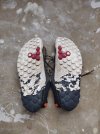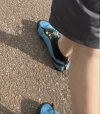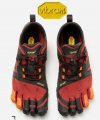Barefoot shoes on the Camino
There wasn't much information about wearing barefoot shoes on the camino but I loved my barefoot experience so I’ve trained and experimented, and I’ve experienced 460 km to Finisterre on barefoot shoes.
In short: I had a great time with them feeling the earth, rocks, twigs, and it has added value to my experience. I did grind away much of the soles and they were eventually almost unbearably uncomfortable.
Introduction
It’s been about nine months since I’ve started walking in barefoot type shoes, I have about five shoes from the brand vivobarefoot. After an injury to my heel last year I found out about these shoes and strengthening my feet in general. To my regret I found barely any information about experience with barefoot shoes on the Camino. So I’ve started experimenting with different models and long walks.
Physical preparation
I've trained walking in barefoot shoes by walking 1,5 hours daily for three months. When I found and developed my preferred way of walking I started walking longer distances. I grew comfortable with a landing in between a forefoot and heel strike: My natural way seems to lightly touch the ground with my heel and then transfer and completely land with the forefoot. I found that a complete forefoot landing was not flexible enough on uneven terrain where it would result in bumping my heel or the middle of my foot in an uncontrolled manner.
However comfortable I grew on super thin soles and concrete, the long distances required more induction for an impact from flesh on asphalt.
The Shoes
I’ve hiked and trained mostly in ‘Vivobarefoot Primus light III’s but I’ve bought ‘Vivobarefoot Tracker decon low FG2’ a month in advance of my camino.I’ve even left the thermal insoles in as that was just the amount of cushioning I needed to be able to walk all day on rough or hard terrain. Before my camino I’ve walked roughly 140 km on them and I found the beginning of wearing on the sole. Tracker Decon in particular but also other FG (Firm ground) soles with some lugs or rubber studs should work alike for this purpose. The added thickness to the sole should help enough with the impact of walking.
The experience
The first two thirds of my 460 km everything went great. I walked exclusively on my Tracker Decon’s, with great delight of feeling the ground and I even found that while climbing or descending mountains it feels like wearing climbing shoes. It seems that the shoes allow your feet and toes to wrap around rocks. After something like 300km the rubber studs on the soles had on the part of my middle foot (see photo) almost completely disappeared and on long days the last few hours were increasingly painful, then the last day making the end of the world in Finisterre and back to the Albergue it had become unbearable to the point I could not distract myself from it often. But resting a bit more underway with feet higher in the air helped in a few minutes to alleviate the feet. It is especially the forefoot that starts with a numb tingling feeling that increases in pain as km pass by. Also compared to others in normal hiking shoes or my past experiences: While descending mountains I think I’ve found that my knees were taking way more energy. It makes sense considering your legs and the foot of your arch act like a spring in landing in barefoot shoes, so that is extra punishment for the knees. I'm a bike courier and my knees are trained and strong. If you have sensitive knees perhaps its good to take some precautions.
What would I do on future Caminos?
Looking back I had a lot of fun and added experience to my trip by wearing barefoot shoes! I wear barefoot shoes exclusively and I wouldn't trade the experience of walking. I have to admit it was stressful to see the sole grinding away and to feel levels of discomfort increasing. But I had only three relatively small blisters, and my feet felt strong. I would probably choose minimalist footwear that is wide enough for my feet yet with a sole that has some more thickness to grind away and perhaps bring light backup barefoot shoes for the rocky terrains as it was so much fun.
It’s no joke for foot health on the long run to be untrained on a trip like the Camino.
But I would recommend my experience, try for yourself with barefoot shoes, but make sure you have a backup plan and that you are trained, also make full days of walking to test your gear. I hope my experience can help you prepare a bit better.
Feel free to ask any questions,
Buen Camino,
Remon Stam

There wasn't much information about wearing barefoot shoes on the camino but I loved my barefoot experience so I’ve trained and experimented, and I’ve experienced 460 km to Finisterre on barefoot shoes.
In short: I had a great time with them feeling the earth, rocks, twigs, and it has added value to my experience. I did grind away much of the soles and they were eventually almost unbearably uncomfortable.
Introduction
It’s been about nine months since I’ve started walking in barefoot type shoes, I have about five shoes from the brand vivobarefoot. After an injury to my heel last year I found out about these shoes and strengthening my feet in general. To my regret I found barely any information about experience with barefoot shoes on the Camino. So I’ve started experimenting with different models and long walks.
Physical preparation
I've trained walking in barefoot shoes by walking 1,5 hours daily for three months. When I found and developed my preferred way of walking I started walking longer distances. I grew comfortable with a landing in between a forefoot and heel strike: My natural way seems to lightly touch the ground with my heel and then transfer and completely land with the forefoot. I found that a complete forefoot landing was not flexible enough on uneven terrain where it would result in bumping my heel or the middle of my foot in an uncontrolled manner.
However comfortable I grew on super thin soles and concrete, the long distances required more induction for an impact from flesh on asphalt.
The Shoes
I’ve hiked and trained mostly in ‘Vivobarefoot Primus light III’s but I’ve bought ‘Vivobarefoot Tracker decon low FG2’ a month in advance of my camino.I’ve even left the thermal insoles in as that was just the amount of cushioning I needed to be able to walk all day on rough or hard terrain. Before my camino I’ve walked roughly 140 km on them and I found the beginning of wearing on the sole. Tracker Decon in particular but also other FG (Firm ground) soles with some lugs or rubber studs should work alike for this purpose. The added thickness to the sole should help enough with the impact of walking.
The experience
The first two thirds of my 460 km everything went great. I walked exclusively on my Tracker Decon’s, with great delight of feeling the ground and I even found that while climbing or descending mountains it feels like wearing climbing shoes. It seems that the shoes allow your feet and toes to wrap around rocks. After something like 300km the rubber studs on the soles had on the part of my middle foot (see photo) almost completely disappeared and on long days the last few hours were increasingly painful, then the last day making the end of the world in Finisterre and back to the Albergue it had become unbearable to the point I could not distract myself from it often. But resting a bit more underway with feet higher in the air helped in a few minutes to alleviate the feet. It is especially the forefoot that starts with a numb tingling feeling that increases in pain as km pass by. Also compared to others in normal hiking shoes or my past experiences: While descending mountains I think I’ve found that my knees were taking way more energy. It makes sense considering your legs and the foot of your arch act like a spring in landing in barefoot shoes, so that is extra punishment for the knees. I'm a bike courier and my knees are trained and strong. If you have sensitive knees perhaps its good to take some precautions.
What would I do on future Caminos?
Looking back I had a lot of fun and added experience to my trip by wearing barefoot shoes! I wear barefoot shoes exclusively and I wouldn't trade the experience of walking. I have to admit it was stressful to see the sole grinding away and to feel levels of discomfort increasing. But I had only three relatively small blisters, and my feet felt strong. I would probably choose minimalist footwear that is wide enough for my feet yet with a sole that has some more thickness to grind away and perhaps bring light backup barefoot shoes for the rocky terrains as it was so much fun.
It’s no joke for foot health on the long run to be untrained on a trip like the Camino.
But I would recommend my experience, try for yourself with barefoot shoes, but make sure you have a backup plan and that you are trained, also make full days of walking to test your gear. I hope my experience can help you prepare a bit better.
Feel free to ask any questions,
Buen Camino,
Remon Stam

Last edited:
























